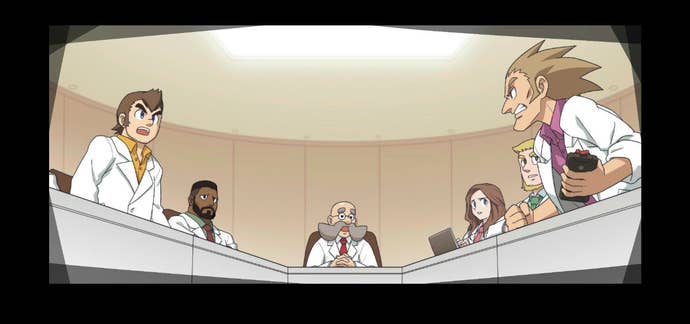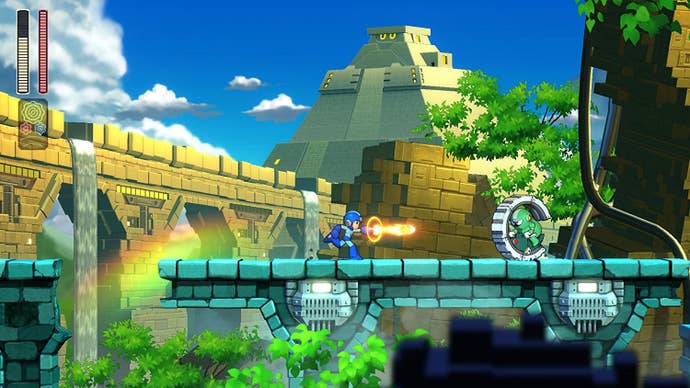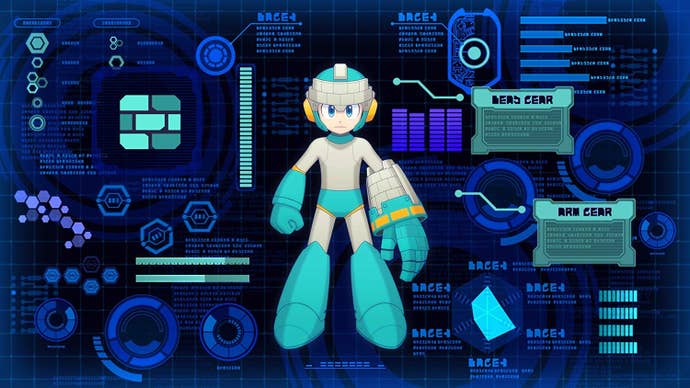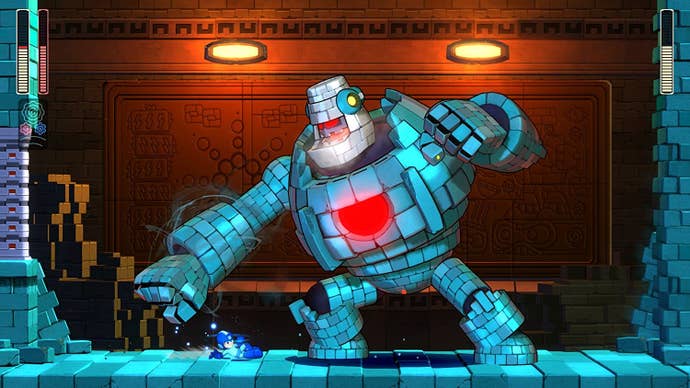Mega Man 11 Review
Get equipped with a happy resurrection.
This article first appeared on USgamer, a partner publication of VG247. Some content, such as this article, has been migrated to VG247 for posterity after USgamer's closure - but it has not been edited or further vetted by the VG247 team.
It's been a rough decade for Mega Man. But there's no need for me to lean back in my chair, puff my pipe, and recount how Capcom exiled the Blue Bomber when the man closest to his name, Keiji Inafune, left Capcom in 2010. YouTube alone is chockablock with Mega Man fans singing the blues, so to speak.
What matters is Mega Man hath risen, and the PlayStation 4, the Xbox One, PC, and the Nintendo Switch are indeed worthy cradles for his rebirth. I'm not suggesting Mega Man is a robot messiah, mind you. But as the sharp, challenging, and fun platforming of Mega Man 11 demonstrates, he's a very good boy. It's nice to have him back.
Mega Man 11 opens with a brief story cinema that illustrates the reason why Dr Wily and Dr Light, once comrades in Robot University, became bitter rivals (please send me a robot owl, or whatever mechanimal delivers invitations to join Robot University). The reason for the break-up revolves around the Double Gear System Dr Wily developed: Though the upgrade can give robots immense power, it dangerously overtaxes their systems. The university rejected Wily's research at Light's behest and awarded Light a grant for studying and applying human-like AI in robots. The millions of Reploids who will die in future Maverick Wars thank you, Dr Light.

When Dr Wily kidnaps and "upgrades" eight of Light's robots by installing his almost-forgotten Double Gear system into their circuits, Mega Man likewise has the upgrade installed so he can fight the newly-turned Robot Masters on equal footing.
The 11th fight for everlasting peace starts how you'd expect: Mega Man instructed to select a Robot Master from a grid-menu of eight mugshots. Whenever he beats a boss, he acquires their weapon. The weapon is the weakness for another robot on the grid, but discovering whose powers affects whom is a matter of trial-and-error. You might travel to the end of a stage, whip out your lone weapon, and discover it does the square root of eff-all to the Robot Master for that level. That's part of the fun / frustration of the Mega Man series. Your job is to return to the main menu, select another Robot Master, and try again.
Mega Man 11 doesn't goof around much with the 30-year-old series' staples. You get your eight Robot Masters, you get your handful of Wily stages, and Bob's your uncle. You won't find surprise rematches with old Robot Masters (a la Mega Man 3) or branching paths (a la Mega Man 6). That's understandable. Mega Man's hibernation was extensive; an entirely new generation of gamers needs to be introduced to the little warrior, so Capcom focused on dishing out the straightforward platforming that made Mega Man games so popular in the first place.

That doesn't mean Mega Man 11 won't sate old fans. I'll just address the Paozo in the room: Mega Man 11 is better than Mighty No. 9, Keiji Inafune's own drab replacement for the Mega Man games. Like, much better. Mega Man 11 has everything Mighty No. 9 lacks: Adorable enemy robots, interesting backgrounds, heart-pounding platforming, clever level design that makes you say "Aha!", and eight Robot Masters who brim with personality despite their brief appearances. Tundra Man's elegant ice-skating routines have already earned him a fanbase, and Block Man's exaggerated movements and loud, barking voice speak of a Robot Master who just tries to do his best, damn it. Also, when I confronted him he told Mega Man he's "just another brick in the wall," and I just can't resist a Pink Floyd reference—no matter how obvious.
Mega Man 11's team seemingly understands this game is a make-or-break moment for our robot friend, so it visibly put a lot of effort into level design and polish. Each level looks distinct and offers its own set of unique challenges. You must dodge Impact Man's separate parts while working your way through his construction site (the robot parts combine when it's time to do battle, a delightful tribute to combining robots like Voltron and Transformers' Combiners). Then you need to find a way to blow up an out-of-control fair ride on Blaster Man's fairgrounds. Acid Man's domain requires you to slosh through pits of liquid that robot minions can turn dangerously acidic at the worst possible time. Thankfully, every leap, slide, and shot feels on-point in Mega Man 11. The demo stirred up some complaints about input lag, but I didn't notice any problems in either the PlayStation 4 or Switch versions of the game.

Mega Man 11's return to "modern" graphics after Mega Man 9 and 10's NES-style sprites might be controversial for some fans of retro gaming, but I'm happy with 2.5D cell-shaded Mega Man (though I might break down and weep if Capcom decides to emulate 32-bit era sprites with the next game). I suppose Mega Man has an eternal claim to 8-bit visuals; after all, Mega Man 9 kicked off a "retro revival" that has yet to peter out. Still, I appreciate how Mega Man 11's detailed backgrounds give us a glimpse into Mega Man's world. When you fight the mini-boss of Torch Man's campground stage, you see a ring of Metool robots enjoying a bonfire. I'm still not over that. I missed those visual touches in Mega Man 9 and 10, which are largely bereft of backgrounds.
Another point of controversy in Mega Man 11 might be the Double Gear system. When I went hands-on with Mega Man 11 at PAX West, I talked about how the Double Gear System feels like it's meant to be used often—like it's not simply meant to be a helping hand to get you through rough spots. But the more I played Mega Man 11, the less often I relied on its Double Gears. I rarely used the Power Gear, and I usually called upon the Speed Gear for seriously tricky moments: There's an insta-kill fire wall at the tail-end of Torch Man's stage that is almost guaranteed to kill you if you don't summon the aid of the Speed Gear (not that I doubt speedrunners and daredevils will prove me wrong). But it doesn't take too much time to get into Mega Man 11's groove, and when you do, you find the Double Gear system is indeed best used for a few seconds at a time to get you out of rough spots.

In fact, one of Mega Man 11's greatest strengths is its myriad difficulty settings. The lowest setting, "Newcomer," takes the bite out of spikes and pits, offers generous checkpoints, and makes Mega Man's regular shot a little stronger while having him absorb less damage. Newcomer is perfect for veteran robot-slaying parents who want to start passing on their skills to the younger generation. The "Casual" setting offers a significant challenge, believe it or not: The only real difference is you start with more lives and encounter more checkpoints (if you're a harried adult, do not be ashamed of selecting the checkpoint-heavy options). "Normal" is what you select if you want to re-capture that unforgiving "Saturday mornings with Mega Man 3" vibe, and "Superhero" is exactly what you need if you eat Mega Man 9 for breakfast.
If you're having a hard time regardless of your selected difficulty, Dr Light runs a shop that you can access any time you're not engaged in a Robot Master's stage. Here, for the price of a few bolts (which litter every stage), you can buy Energy Tanks, extra lives, and physical guards against spikes and pits. Permanent upgrades can also help you get through especially knotty areas: There's an upgrade that lets you move at normal speed when you have the Speed Gear enabled. It's a godsend for the aforementioned insta-kill fire wall portion of Torch Man's stage.

Dr Light's assistant robot, Auto, belts out a hearty greeting every time you visit the store, which is a constant reminder of Mega Man 11's weakest aspect: Its sound. While the voice acting isn't bad, some of the characters are grating or lifeless. Auto is the former. Dr Light sounds sedated. Dr Wily is perfect, thankfully—and anyway, even the worst performance in Mega Man 11 sounds like an angels' choir compared to puddle of auricular diarrhea we got for Mega Man 8's cutscenes. Unfortunately, an average voice performance is only half of Mega Man 11's sound problem; its music doesn't touch the admittedly lofty bar set by previous games. Everything sounds fine, but "fine" doesn't cut it in a series that gave us Dr Wily Stage 1, Skull Man, Charge Man, and Shade Man. Mega Man music is famous for grabbing players on the first pass, and none of Mega Man 11's scores manage to do that.
Hopefully we'll get some better voice acting and music next time—and by gosh, I do hope there's a "next time." Whatever you might think of its visuals and Double Gear system, Mega Man 11 marks a return to the top-tier platforming we love. Mega Man's had a long time to recharge his batteries: Let's see what else he can do.
ConclusionMega Man is back from exile, and he brought a nice gift for us to show there's no hard feelings. Mega Man 11 brings back the same high-quality platforming that made the Blue Bomber a household name in the '80s and '90s, and the new Double Gear system shakes up the classic gameplay without feeling like an intrusion.










